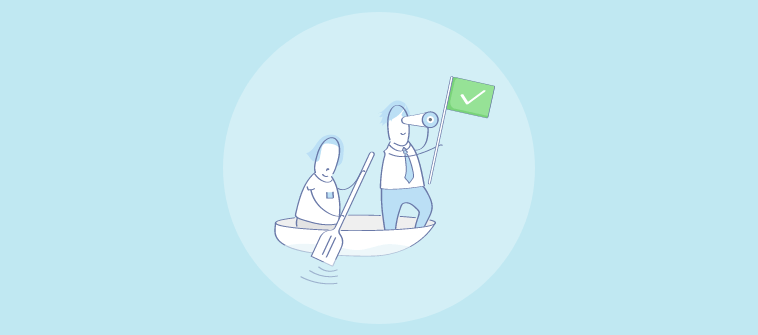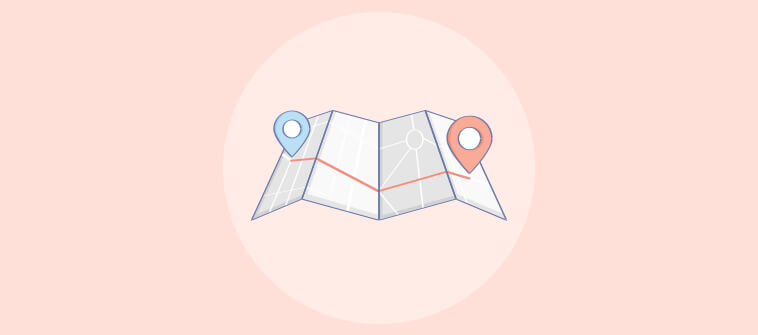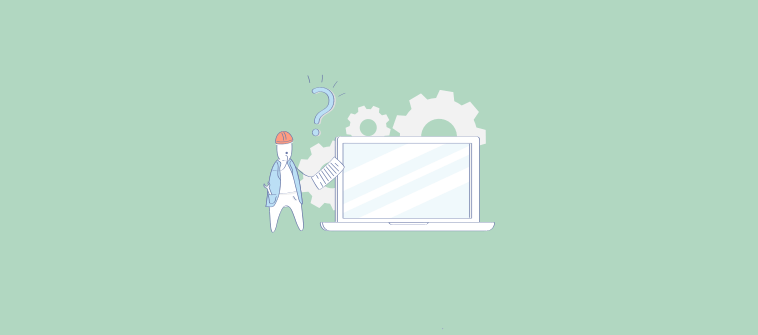
As project and team manager, you shoulder the responsibility of delivering projects on time and within budget. But, keeping track of simultaneously running projects can be a daunting task.
To support your project management practices, you need a sound project visualization system, one that forms the backbone of all your project tracking activities.
And here is where the Gantt chart vs Kanban board debate surfaces!
Now, it’s important to understand that both offer different capabilities. While Gantt charts give you a bird’s eye view of everything that’s going on within your project, Kanban steps in to give you a detailed view of your project tasks. Both undeniably, help you monitor the pulse of your project effortlessly.
This blog will delve into the difference between Gantt and Kanban and how you can implement them effectively.
What Is a Gantt Chart?
A Gantt chart consists of vertical and horizontal axes. The vertical sidebars display the task and subtask names. The horizontal bars next to the vertical ones display the tasks scheduled within a project. These bars spread throughout the due dates that they are scheduled for, displaying the timeline of a task. Also, these are colored bars and provide real-time task progress at a glance.
A Gantt chart offers you insight into the following:
- Tasks and subtasks of a project
- Start and end dates of a task
- Assigned members
- Timeline of a task
- Task dependencies
Read More: What is a Gantt Chart & How to Use Gantt Charts for Project Planning
Gantt Chart Example
To give you an idea of how it works, here’s an example of ProProfs Project.
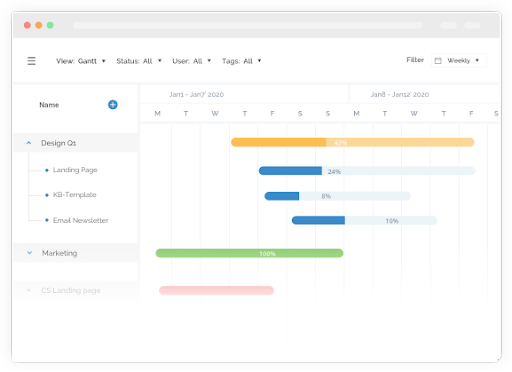
In this, “Design Q1” represents the task of a project. The horizontal orange bar against it represents the timeline within which it must be completed. Also, 42% represents the progress made on the task.
Now, “Landing Page,” “KB-Template,” and “Email Newsletter” are the subtasks of “Design Q1.” And the blue horizontal bars represent the task timelines and their progress, respectively.
The Gantt chart is easy-to-understand and gives you an overview of how much progress is made within each task and the overall project.
Read More: 15 Gantt Chart Examples for Project Management
Advantages of Using the Gantt Chart
To understand the Gantt chart vs Kanban board debate, let’s first scoop up the advantages of Gantt chart.
- High-level view: The chart gives a clear overview of all your tasks and their respective start and end dates.
- Project tracking: The horizontal bars display the percentage of progress of a task. This helps map out whether the project will be accomplished within the set timeframe.
- Baselining: The Gantt baseline lets you measure the progress of a task as compared to a different time period during project execution.
- Dependency management: You can view which tasks are dependent on each other and oversee the timely completion of dependent tasks for smooth project delivery.
- Task status: The colored circles next to the task titles on the vertical sidebar represent the status of tasks. For example, the green circle indicates an ongoing task.
- Adaptive workflows: You can drag and drop tasks and their timelines to adjust workflows as required using gantt chart software.
You can refer to this video to understand Gantt charts better.
Disadvantages of Using the Gantt Chart
While the Gantt chart has significant advantages, it also comes with its disadvantages.
Let’s not ignore them completely and consider them while using the Gantt for project visualization. The disadvantages are:
- While working with the Gantt chart, you create tasks, assign users, and set the timeline. Now, when you’re working with large or complex projects involving a large number of tasks and subtasks, these details can get overwhelming.
- Setting up the Gantt chart may consume considerable time, which you can otherwise direct to high-level tasks.
- It does not display the task priorities within the project, which may create confusion regarding which tasks team members must deliver first.
Keeping these limitations in mind, let’s see where you can apply Gantt charts for effective work visualization.
Read More: Advantages and Disadvantages of Gantt Chart
Where to Apply Gantt Charts?
You can apply and utilize the Gantt chart for managing projects that require you to track task progress and their timelines.
A few industries where Gantt has proven to offer significant benefits are:
- Software development
- Consulting
- Healthcare
- Education
- Marketing
- Construction
- Retail
Thus, you can say that a Gantt chart is a great option for businesses across various industries.
What Are Kanban & Kanban Board?
Kanban is a project management methodology that helps divide project tasks and activities into workflows. This way, you know which task is at which stage of completion simply at a glance.
A Kanban board helps visualize the status of tasks that are divided into different stages of project execution.
The board consists of vertical columns representing workflows. The Kanban board’s workflows imply the stages a task goes through during the project’s life cycle. The most common workflows include “To-do,” “In Progress,” “On Hold,” and “Done.” However, as a project manager, you can create many more or different workflows to suit your project and team’s requirements.
The workflow columns have cards within them. These cards are the tasks that constitute the project. Each task card holds all information about a task, such as a task title, assigned team members, due dates, and file attachments.
You put tasks in the column that signifies where they stand. For example, if a task is in progress, it will come under the “In Progress” column. Similarly, if a task is completed, you will drag and drop its card to the “Done” column.
Read More: Kanban Project Management Everything you Need to Know
Kanban Board Examples
Here’s a glimpse at what a marketing Kanban board may look like:
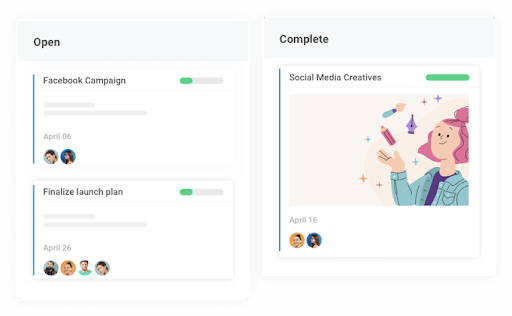
Here, we have shown only two workflows, “Open” and “Complete,” to help you easily understand the Kanban board’s mechanism.
The “Open” workflow has two tasks, “Facebook Campaign” and “Finalize launch plan,” while the “Complete” workflow has only one task, “Social Media Creatives.”
You can clearly see each task’s name, its assigned team members, the due dates, and the progress of the specific tasks.
Now, as you work on the Facebook campaign and accomplish its deliverables, you drag and drop the card into the “Complete” column to signify its completion. Similarly, as you work on the next tasks and successfully finalize the launch plan, you also drag its card into the right column. That’s it! That’s how simple it is. This helps everybody in the team stay accountable for the work assigned to them and also helps keep everyone up-to-date when a task is completed. This way, the team faces no confusion regarding task responsibilities, and achieves set goals on time and within budget.
Read More: 15 Kanban Boards Examples For Teams in 2022
Advantages of Using the Kanban Board
To understand the Kanban board vs Gantt chart comparison, you must also delve into the advantages of the Kanban board.
- Better task visibility: The Kanban cards offer every detail of a task, i.e. individual task progress, end dates, assignees, and followers. Click on a task card, and a side window will open, displaying more intricate details about the task.
- Transparent workflows: Kanban provides transparency with its workflows. This means that if you wish to see how projects will move forward, you can look at the workflow order.
- Effortless change management: If you run into a situation where you need to change workflows and prioritize tasks immediately, Kanban is what you need. It allows you to quickly make changes with a couple of clicks and get started with new workflows instantly.
- Easy task management: The Kanban board gives you an overview of everything within the project’s purview on a single screen. You can even filter the cards by their status or assigned team members, giving you a better grasp of where your project stands.
Disadvantages of Using the Kanban Board
Now, let’s also look at Kanban’s disadvantages.
- The Kanban board is not really suitable for new project workflows. However, if you’re working with projects with recurring workflows, then Kanban will work well for you.
- Kanban is apt for working with simple workflows, i.e., if your project does not involve ever-evolving workflows or integrating frequent client suggestions.
- Kanban focuses on phases. The timeframes of tasks often get lost and do not gain proximity within the workflows, which may cause deadlines to be missed easily.
- Kanban may require you to use it in combination with other project management tools such as Scrum, Lean, or Agile for best results.
Read More: 20 Best Kanban Board Software for 2022
Where to Apply the Kanban board?
You can apply the Kanban board if you want to better understand the tasks’ status during project execution. . The board gives an insight into which tasks are in progress, which ones are on hold, which ones are completed, and much more. This lets you track the project’s process as per the expectations.
Also, Kanban works well across projects with repetitive workflows. It is not desirable to start creating the Kanban board for drastically different projects. This is because too much effort goes into creating the various workflows and the number of tasks within each of them.
Another thing to note is that Kanban works best when applied in combination with other project management methodologies.
Read More: Kanban Vs Scrum: What’s The Difference
Gantt Chart vs Kanban Board
Let’s look at this table elaborating Gantt chart vs Kanban board with key difference points.
| Key Differences | Gantt Chart | Kanban Board |
| Best for | Visualizing tasks with timelines. | Visualizing tasks and their status. |
| Context | The view is not apt for manufacturing projects. | The view was mainly utilized for manufacturing projects but is used for projects across different industries today. |
| Suitable for | Works well for projects involving drastic requirements and workflows. | Works well for projects involving similar requirements and workflows. |
| Dependencies | Dependencies form a crucial part of Gantt workflows. | Dependencies do not hold significant relevance in Kanban workflows. |
| Change management | Not very adaptive to new projects and schedule changes. | Incorporates change management smoothly. |
Visualize Real-Time Progress with Gantt & Kanban in Combination!
By now, you must have a fair idea of the Gantt chart vs Kanban board argument. It’s important to realize that while there may be a difference between Gantt and Kanban, they work best when combined.
So, you can switch between both views and extract better results from the increased project and task visibility. Confused how to integrate the two? Don’t worry! Here is where a good project visualization solution comes into play.
A robust system like ProProfs Project offers interactive views, including Gantt charts and Kanban boards that help track projects and tasks in real time. You can use the Gantt view to get an overview of all your project’s schedule. Also, you can switch to the Kanban view with just a single click, gaining more visibility into your tasks and their current status and workflow.
This combination helps you monitor your tasks and accomplish projects on time without a hitch. The tool offers a free 15-day trial that helps you analyze whether it would benefit your project and team needs.
If you’re looking for other project visualization solutions that offer both Gantt and Kanban, then you can also try ClickUp and Asana for their good project tracking capabilities.
FREE. All Features. FOREVER!
Try our Forever FREE account with all premium features!

